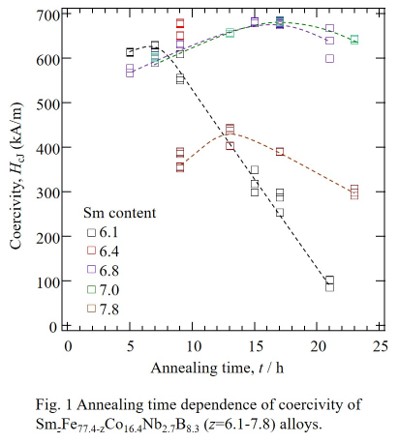Presentation Information
[O10-2]Composition dependence on magnetic properties and phase changes of TbCu7-type Sm-Fe-Co-Nb-B alloys
*Masashi MATSUURA1, Shinya SAKURADA2, Satoshi SUGIMOTO1 (1. Tohoku University (Japan), 2. Toshiba (Japan))
Keywords:
TbCu7-type Sm-Fe phase,Coercivity,Anisotropy field,phase and microstructural changes
A TbCu7-type Sm-Fe phase in melt-spun ribbons with good magnetic properties, and in 1996, Sakurada et al. [1] prepared a TbCu7-type Sm-Fe-N based compound with high intrinsic magnetic properties of saturation magnetization and anisotropy field of 1.70 T and 6.2 MAm-1, respectively. In 2002, Mochizuki et al. [2] reported that a high coercivity TbCu7-type compound could be obtained with relatively slow roll velocity and without nitriding. Recently, our group also focused on the Sm-Fe-Co-Nb-B alloy system, and achieved a high coercivity of 655 kAm-1 with a TbCu7-type phase in Sm6.2Fe68.7Co16.4Nb2.7B8.3 by optimizing the annealing conditions [3]. In this work, we investigated the influence of the composition on the magnetic properties including coercivity, magnetization, and anisotropy field, and microstructure of Sm-Fe-Co-Nb-B alloys with the goal of enhancing the coercivity.
SmzFe77.4-zCo16.4Nb2.7B8.3 (at%) (z=6.1-7.8) alloys were subjected to induction melting followed by melt spinning to obtain amorphous ribbons. The melt-spun ribbons were heat treated at 635 °C for 1–25 h. The magnetic properties were evaluated by VSM with maximum applied field of 1.6 MAm-1 after magnetized by a pulsed magnetic field of 6.4 MAm-1. The anisotropy field was estimated using the law of approach to ferromagnetic saturation (LAS) method under applying a maximum magnetic field of 4.8 MAm-1. The crystallization temperature was measured by DSC and the crystal structure was determined by XRD. The annealing time dependence was shown in Fig. 1. For z=6.1 at%, coercivity showed a peak by annealing for 7 h, and it tended to decrease by annealing with extending time. The optimum annealing time for coercivity increased with increasing Sm content to z=7.0 at%, and the optimum annealing time was 17 h for the alloy with z=7.0 at% resulting in 682 kA/m. Further increasing Sm to 7.8 at%, optimum annealing time was short to 13 h, and the maximum coercivity was lower than that of z=7.0 at%. The trend of coercivity changes corresponds to anisotropy field changes. LAS measurement revealed that the anisotropy field tended to increase with increasing Sm content, furthermore, the XRD analysis showed the c/a of TbCu7-type phase tended to be small with increasing Sm content. Therefore, Sm content effects on not only coercivity but also anisotropy field of TbCu7-type phase. The details of microstructure and magnetic properties will be discussed on the presentation.
[1] S. Sakurada, et al., J. Appl. Phys., 79 (1996) pp. 4611–4613.[2] M. Mochizuki, et al., Proceedings of the Seventeenth International Workshop on Rare Earth Magnets and Their Applications, Newark, Delaware, USA (2002) pp. 401–408.[3] N. Kurokawa, et al., J. Magn. Magn. Mater., 556 (2022) pp. 169414 1-9.
Acknowledgement: This study was supported by New Energy and Industrial Technology Development Organization (NEDO), Japan (JPNP23030).
SmzFe77.4-zCo16.4Nb2.7B8.3 (at%) (z=6.1-7.8) alloys were subjected to induction melting followed by melt spinning to obtain amorphous ribbons. The melt-spun ribbons were heat treated at 635 °C for 1–25 h. The magnetic properties were evaluated by VSM with maximum applied field of 1.6 MAm-1 after magnetized by a pulsed magnetic field of 6.4 MAm-1. The anisotropy field was estimated using the law of approach to ferromagnetic saturation (LAS) method under applying a maximum magnetic field of 4.8 MAm-1. The crystallization temperature was measured by DSC and the crystal structure was determined by XRD. The annealing time dependence was shown in Fig. 1. For z=6.1 at%, coercivity showed a peak by annealing for 7 h, and it tended to decrease by annealing with extending time. The optimum annealing time for coercivity increased with increasing Sm content to z=7.0 at%, and the optimum annealing time was 17 h for the alloy with z=7.0 at% resulting in 682 kA/m. Further increasing Sm to 7.8 at%, optimum annealing time was short to 13 h, and the maximum coercivity was lower than that of z=7.0 at%. The trend of coercivity changes corresponds to anisotropy field changes. LAS measurement revealed that the anisotropy field tended to increase with increasing Sm content, furthermore, the XRD analysis showed the c/a of TbCu7-type phase tended to be small with increasing Sm content. Therefore, Sm content effects on not only coercivity but also anisotropy field of TbCu7-type phase. The details of microstructure and magnetic properties will be discussed on the presentation.
[1] S. Sakurada, et al., J. Appl. Phys., 79 (1996) pp. 4611–4613.[2] M. Mochizuki, et al., Proceedings of the Seventeenth International Workshop on Rare Earth Magnets and Their Applications, Newark, Delaware, USA (2002) pp. 401–408.[3] N. Kurokawa, et al., J. Magn. Magn. Mater., 556 (2022) pp. 169414 1-9.
Acknowledgement: This study was supported by New Energy and Industrial Technology Development Organization (NEDO), Japan (JPNP23030).

